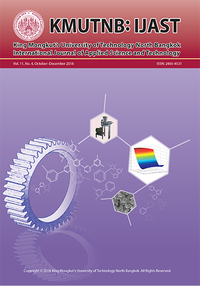Design of a Varying Die-plate Fish Feed Pelletizer and Performance Evaluation Using a Non-conventional Feed Sources
Main Article Content
Abstract
An electrically-operated fish feed pelletizer was designed, fabricated and tested. The machine was incorporated with an easily detachable die plates capable of extruding different sized feed. Performance evaluation of the machine was carried out using a non-conventional feed resources of fermented citrus and plantain peels each formulated with fish feed constituents such as fish oil and groundnut cake prepared at a moisture content of 20% wet basis. The performance indices considered in the evaluation of the pelletizer were pelleting efficiency, percentage recovery and percentage of unpelleted feed. Results obtained when 250 g of formulated feed was introduced into the pelletizer showed an higher pelleting efficiency (91.50%), percentage recovery (73.20%) and a lower percentage of unpelleted feed (26.81%) when die plate having screen size of 5 mm holes was used. Evaluation using die plate having 3 mm holes showed that the average values for pelleting efficiency, percentage recovery, and percentage unpelleted feed were 82.09, 65.67 and 35.73% respectively. Statistical analysis of the performance indices with respect to the 3 mm and 5 mm die sizes showed that performance indices had significant difference on formulated feed having fermented citrus peel while not statistically significant for feed formulated with fermented plantain peel at p < 0.05.
Article Details
References
[2] C. C. Ugoamadi, “Development of a cassava technology,” Nigerian Journal of Technology, vol. 31, no. 3, pp. 233–240, 2012.
[3] L. Lahaye, P. Ganier, J. N. Thibault, and B. Steve, “Technological processes of feed manufacturing affect protein endogenous losses and amino acids availability for body protein deposition in pigs,” Animal Feed Science and Technology, vol. 113, pp. 141–156, 2014.
[4] M. W. Greenwood and K. S. Beyer, “Effect of feed manufacturing practices on nutrient availability and feed quality,” in Proceedings of the 30th Annual Carolina Poultry Nutrition Conference, 2003, pp. 7–16.
[5] A. M. Amerah, V. Ravindran, R. G. Lentle, and D. G. Thomas, “Influence of feed particle size on the performance energy utilization, digestive tract development, and digesta parameters of broiler starters fed wheat and corn based diets,” Poultry Science, vol. 87, pp. 2320–2328, 2008.
[6] C. N. Nwaokocha and O. O. Akinyemi, “Development of a dual-mode laboratory-sized pelletizing machine,” Leonardo Journal of Sciences, vol. 13, pp. 22–29, 2008.
[7] E. A. Fasakin, “Fish as food yesterday, today and forever,” Federal University of Technology, Akure, Nigeria, 2008.
[8] L. C. Nwanna, “Nutritional value and digestibility of shrimp head waste meal by Africa Catfish Clarias gariepinus,” Pakistani Journal of Nutrition, vol. 2, no. 6, pp. 339–345, 2003.
[9] O. A. Sogbesan, Non-conventional Animal Protein Feedstuffs for the Culture of Catfish. Ibadan: Ibadan University Press, 2014, pp. 2.
[10] A. O. Sotolu, “Nutrient potentials of water hyacinth as a feed supplement in sustainable aquaculture,” Obeche, vol. 26, no. 1, pp. 45–51, 2008.
[11] G. Pandey, “Feed formulation and feeding technology for fishes,” International Research Journal of Pharmacy, vol. 4, no. 3, pp. 23–30, 2013.
[12] T. K. Kaankuka and D. T. Osu, “Development of a revolving die and roller fish feed pelletizer,” International Journal of Engineering Innovation and Research, vol. 2, no.1, pp. 105–110, 2013.
[13] S. S. I. Diarra, D. Kwari, and H. D. Kwari, “Effect of substituting wheat bran with millet bran on nutrients digestibility and intestinal morphology of broiler chickens,” in Proceedings of the 6th Annual Animal Science Association of Nigeria, 2001, pp. 64.
[14] B. Amadi, Fish Farming Technology: Principles and Practical. Ellis: Jos, 2007, pp. 31–42.
[15] A. D. Romallosa and J. C. Cabarles Jr, “Design and evaluation of a pellet mill for animal feed production,” Central Philippine University, Iloilo, Philippine, 2015.
[16] B. R. Burmamu, B. Aliyu, and T. S. K. Tya, “Development of a manually operated fish feed pelleting machine,” International Journal of Research in Engineering and Advanced Technology, vol. 2, no. 6, pp. 23–32, 2015.
[17] O. A. Olugboji, M. S. Abolarin, M. O. Owolewa, and K. C. Ajani, “Design, construction and testing of a poultry feed pellet machine,” International Journal of Engineering Trends and Technology (IJETT), vol. 22, no. 4, pp. 168–172, 2015.
[18] A. O. Ojomo, L. A. Agbetoye, and F. O. Ologunagba, “Performance evaluation of a fish feed pelletizing machine,” ARPN Journal of Engineering and Applied Sciences, vol. 5, no. 9, pp. 88–97, 2010.
[19] M. K. Bolade, “Effect of flour production methods on the yield, physicochemical properties of maize flour and rheological characteristics of a maize-based non-fermented food dumpling,” African Journal of Food Science, vol. 3, no.10, pp. 288–298, 2009.
[20] H. D. Olusegun and A. S. Adekunle, “Design, construction and testing of a worm-like pellet fish meal processing machine,” International Journal of Engineering, vol. 3, no 1, pp. 31–44, 2009.
[21] G. Sitkei, Mechanics of Agricultural Materials. Budapest: Elsevier Science Publishers, 1986.
[22] J. E. Shigley, L. D. Mitchell, and R. G. Buchynas, Mechanical Engineering Design, 7th ed., New York: McGraw Hill, 2004.
[23] R. S. Khurmi and J. K. Gupta, A Textbook of Machine Design. Ram Nagar, New Delhi: Eurasia Publishing House (PVT.) Ltd., 2006.
[24] O. O. Akinyemi, “Production and performance evaluation of an electrode coating machine,” M.S. thesis, Department of Industrial and Production Engineering, University of Ibadan, Ibadan, Nigeria, 2002.
[25] AOAC, “Official methods of analysis of AOAC international,” 21st ed., Washington DC, 2012.
[26] U. O. Ugalde, J. I. Castrillo, “Single cell proteins from fungi and yeasts,” Applied Mycology and Biotechnology, vol. 2, pp. 123–149, 2002.
[27] A. O. Ubalua and O. U. Ezeronye, “Growth responses and nutritional evaluation of cassava peel based diet on tilapia (Oreochromis niloticus) fish fingerlings,” Journal of Food Technology, vol. 6, no. 5, pp. 207–213, 2008.


